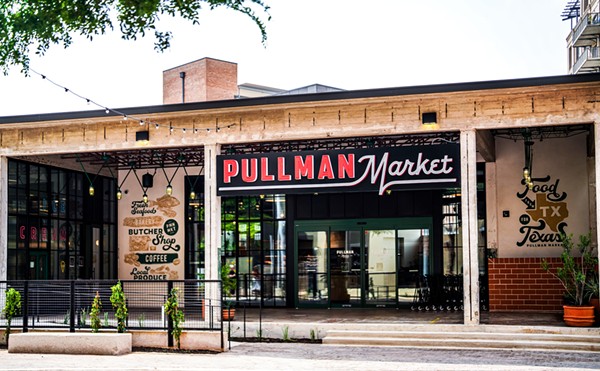On a brisk spring morning, the vines at Red Caboose Winery are speckled with tiny buds. Amid downy leaves no bigger than a fingertip, miniature grape clusters drink in the sun. Gary McKibben regards them with pride. They are living proof that his vision for a sustainable winery is becoming a reality. That, and they’ll make a hell of a Tempranillo come harvest time.
“I’m about as green as they come,” boasts McKibben, a Dallas-based architect who specializes in eco-friendly design. Red Caboose is his latest project, and arguably the one closest to his heart. “This is something I wanted to do 35 years ago in California,” he explains, gazing out over the rolling Central Texas countryside. As happens in so many cases, life took a different path, and his dream of opening a winery was put on the back burner while he concentrated on family and career. Now things have come full circle, with an added bonus: McKibben’s son Evan is along for the ride. The younger McKibben, a reserved counterpart to his energetic father, makes for the perfect partner to share in growing and winemaking duties at Red Caboose.
Set nearly a mile off the main road just outside of Meridian, this small winery lies at the end of a meandering oak- and pecan-lined driveway. Wide verandas full of rustic furniture invite visitors to take in views of the adjacent vineyard. You’ll have to look a little closer, however, to notice everything that makes Red Caboose so very different.
McKibben begins a tour of the property by unrolling a set of oversized plans across the bar in his tasting room — a bar, incidentally, that’s crafted from recycled oak barrels. With the wide-eyed enthusiasm of an inventor, McKibben points out the winery’s most notable features. Eight underground geothermal wells provide year-round cooling and refrigeration, and gabions, giant rock-filled cages, make up a few exterior walls. Since breaking ground in 2005, McKibben has followed the U.S. Green Building Council’s Leadership in Energy and Environmental Design Certification guidelines, which have become the gold standard for “green” design in the United States and many countries around the world. Just about every design feature at Red Caboose serves an ecological purpose.
For instance, large silos tucked on either side of the winery catch rainwater to be reused in the irrigation process. According to Evan, the neutral pH of rainwater happens to be just what his vines crave. “It’s the most neutral water you can get without putting chemicals in it,” he explains. With just three inches of rain, the winery is able to collect 19,000 gallons of usable rainwater.
And those gabions? They’re filled with rocks removed from the vineyards during planting that have been repurposed as building material. They appear throughout the property, flanking a driveway or adding a Texas-chic element to the main building’s architecture. Nothing goes to waste here. Indeed, the Red Caboose itself is a grand old 1946 Santa Fe that was destined for the scrap yard until the elder McKibben picked it up for a few pennies a pound. So even the winery’s mascot is a tribute to the familiar Earth Day slogan, “Reduce, Reuse, Recycle.”
This idea of a “green” vineyard and winery is new to Texas. While the concept has been catching on in California at wineries such as Fetzer Vineyards, and in Oregon, home to the country’s first two LEED-certified wineries, the Lone Star State has lagged behind. McKibben is working to change that. In recent years, he has designed several Texas wineries, and as part of the process he is educating our wine community about eco-friendly practices.
Brennan Vineyards in Comanche is a McKibben design. “I thoroughly enjoyed working with Gary in designing our winery,” says owner Pat Brennan. While his is a traditional facility, Brennan admires what McKibben has created at Red Caboose. “Gary is on the cutting edge of the green movement in winery design and construction,” he raves.
Recently, McKibben has moved past the education phase and into implementation. A few of the wineries he’s working on right now will be utilizing green design features. “I’m designing three wineries right now,” he explains, “and all three of them are using geothermal.” He couldn’t be more excited about it.
What with all the design and execution going on, it would be easy to understand if Red Caboose was a little slower to catch up in the wine department. On the contrary, the McKibbens are excelling in that area as well. Bronze medals were awarded to their 2005 Viognier and 2005 Cabernet Sauvignon at last year’s Lone Star International Wine Competition. Their 2006 Cabernet-Syrah also met with critical acclaim.
“We’re off to a good start,” says McKibben with a knowing smile. The ace up his sleeve is that a few of his earth-friendly practices also make for better wine. Gravity is a case in point. Red Caboose is oriented so that natural flow, as opposed to electric pumps, can be used whenever possible to transport wine through the crushing, fermenting, and bottling processes. In addition to conserving energy, many in the know believe that this gentle handling makes for a superior end product. (A similar process is used at Napa’s prestigious Opus One winery to notable result.) McKibben explains the simple philosophy behind this practice: “We don’t want to disturb the wine any more than we have to.”
Everything seems right on track at Red Caboose. The winery has even begun to attract a growing crowd of visitors. As the newest member of the Way Out Wineries, a group of Central Texas vintners collectively off the beaten path, a growing number of wine enthusiasts are becoming acquainted with Red Caboose. “We’re getting people that come back, and they’re bringing other people with them,” Evan says. “It’s been really nice.” In addition to participating in the Way Out Wineries’ Road Trips, Red Caboose hosts individual events on weekends. Visitors can enjoy candle-lit dinners in the barrel and bottling room, surrounded by American Oak.
Looking to the future, Gary and Evan are excited about this year’s crop of Tempranillo, and the winery will host a special Taste of Tempranillo event when it’s ready for sampling. More green design features are also on the horizon.
“We’re as sustainable as we can be at this point,” McKibben observes, but that’s not quite good enough for this eco-architect. To complement his geothermal wells, McKibben plans to install photovoltaic cells on the roof to provide Red Caboose with its own solar-driven power source. “I will be able to totally sustain our chilling, cooling — everything,” he says. Phase Two, as this expansion is called, will also include the addition of bed-and-breakfast accomodations, an amphitheater, and new dining and kitchen facilities. Construction is already underway. Gary McKibben waited 35 years, and now he’s not wasting any time.
Find more info on Red Caboose and Way Out Wineries events at wayoutwineries.org














